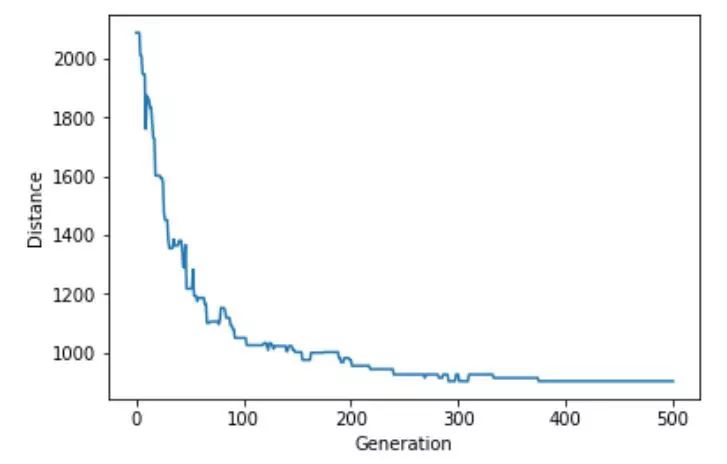旅行销售员的演化:基于Python实现遗传算法
编者按:麦肯锡顾问Eric Stoltz以旅行推销员问题为例,简明地介绍了遗传算法的原理及Python实现。
借鉴自然选择的灵感,遗传算法(GA)是一种迷人的求解搜索和优化问题方法。尽管已经有很多关于GA的文章,这些文章很少演示如何一步一步地使用Python实现GA算法,解决一个比较复杂的问题。所以我写了这篇教程!读完这篇教程后,你将对如何从头实现GA算法有一个完整的了解。
导言
问题
这篇教程将使用GA求解旅行推销员问题(TSP):
给定一系列城市和每对城市之间的距离,求解访问每一座城市一次并回到起始城市的最短路由。
TSP示意图(作者:Xypron;许可:公有领域)
记住两条重要的规则:
每座城市仅访问一次(不重不漏)
必须返回起始城市
方法
让我们从一些定义开始:
基因(gene): 一座城市(以(x, y)坐标表示)
个体(individual)或染色体(chromosome): 满足以上条件的一个路由
种群(population): 一组可能的路由(即,一组个体)
父母(parents): 两个路由相组合,创建一个新路由
交配池(mating pool): 一组父母,用来创建下一代种群(即创建下一代路由)
适应度(fitness): 一个告诉我们每个路由有多好的函数(在我们的例子中,也就是距离多短)
突变(mutation): 在种群中引入变化的方法,随机交换路由中的两个城市
精英选择(Elitism): 将最好的个体保留至下一代
GA算法的进行过程如下:
创建种群
确定适应度
选择交配池
繁殖
变异
重复
现在,让我们来动手实现。
创建我们的遗传算法
导入一些机器学习的标准包:
import numpy as np
import random
import operator
import pandas as pd
import matplotlib.pyplot as plt
创建城市和适应度类
我们首先创建City(城市)类,城市不过是(x, y)坐标。City类中包含distance函数(根据勾股定理计算一对城市间的距离)。
class City:
def __init__(self, x, y):
self.x = x
self.y = y
def distance(self, city):
xDis = abs(self.x - city.x)
yDis = abs(self.y - city.y)
distance = np.sqrt((xDis ** 2) + (yDis ** 2))
return distance
def __repr__(self):
return "(" + str(self.x) + "," + str(self.y) + ")"
在Fitness(适应度)类中,我们将适应度(routeFitness)定义为路由距离(routeDistance)的倒数。我们想要最小化路由距离,因此较大的适应度较优。注意routeDistance的定义考虑到了我们需要回到起点。
class Fitness:
def __init__(self, route):
self.route = route
self.distance = 0
self.fitness= 0.0
def routeDistance(self):
if self.distance ==0:
pathDistance = 0
for i in range(0, len(self.route)):
fromCity = self.route[i]
toCity = None
if i + 1 < len(self.route):
toCity = self.route[i + 1]
else:
toCity = self.route[0]
pathDistance += fromCity.distance(toCity)
self.distance = pathDistance
return self.distance
def routeFitness(self):
if self.fitness == 0:
self.fitness = 1 / float(self.routeDistance())
return self.fitness
创建种群
现在我们将生产初始种群(第一代)。我们需要一个能够生成满足条件的路由的函数(我们将在教程末尾创建城市列表)。我们通过随机选择访问城市的顺序创建一个个体:
def createRoute(cityList):
route = random.sample(cityList, len(cityList))
return route
重复运行createRoute函数,直到我们有了足够的个体:
def initialPopulation(popSize, cityList):
population = []
for i in range(0, popSize):
population.append(createRoute(cityList))
return population
确定适应度
接下来到了有意思的演化部分。为了模拟“适者生存”,我们利用Fitness排序种群中的每个个体。我们的输出是一个有序列表,包括路由ID和相应的适应度分数。
def rankRoutes(population):
fitnessResults = {}
for i in range(0,len(population)):
fitnessResults[i] = Fitness(population[i]).routeFitness()
return sorted(fitnessResults.items(), key = operator.itemgetter(1), reverse = True)
选择交配池
选择用来产生下一代的父母有若干种方法。其中最常见的两种是适应度比例选择(fitness proportionate selection)和锦标赛选择(tournament selection)。适应度比例选择又称为轮盘赌选择(roulette wheel selection)。
适应度比例选择 (下面实现的版本):基于每个个体相对于种群的适应度分配选中的概率。可以看成适应度加权选择概率。
锦标赛选择:从种群中随机选择一些个体,其中适应度最高的被选为父母的一方。重复这一过程选出父母的另一方。
另外也可以考虑精英选择。种群中表现最优的个体自动进入下一代,确保留存最成功的个体。
为清晰计,我们将分两步(selection、matingPool)创建交配池。在selection函数中,我们将根据rankRoutes的输出判定选择哪些路由。我们为每个个体计算相对适应度权重(创建轮盘),然后将这些权重与一个随机数比较,以选择交配池。同时,我们打算保留最佳的路由,因此引入了精英选择。最后,selection函数返回路由ID的列表,供matingPool函数使用。
def selection(popRanked, eliteSize):
selectionResults = []
df = pd.DataFrame(np.array(popRanked), columns=["Index","Fitness"])
df['cum_sum'] = df.Fitness.cumsum()
df['cum_perc'] = 100*df.cum_sum/df.Fitness.sum()
for i in range(0, eliteSize):
selectionResults.append(popRanked[i][0])
for i in range(0, len(popRanked) - eliteSize):
pick = 100*random.random()
for i in range(0, len(popRanked)):
if pick <= df.iat[i,3]:
selectionResults.append(popRanked[i][0])
break
return selectionResults
有了selection提供的路由ID,我们可以创建交配池了。
def matingPool(population, selectionResults):
matingpool = []
for i in range(0, len(selectionResults)):
index = selectionResults[i]
matingpool.append(population[index])
return matingpool
繁殖
创建好了交配池后,我们可以通过交叉(crossover)过程生产下一代。例如,假设个体是由0和1组成的字符串,我们可以直接选定一个交叉点,铰接两个字符串以产生后代。
然而,TSP要求每个位置出现且仅出现一次。为了遵循这条规则,我们将使用一种特殊的繁殖函数有序交叉(ordered crossover)。在有序交叉中,我们随机选择父字符串的一个子集,然后用母字符串中的基因填充路由的剩余空位。填充时,按照基因在母字符串中出现的次序依次填充,跳过选中的父字符串子集中已有的基因。
有序交叉示意图(来源:Lee Jacobson)
def breed(parent1, parent2):
child = []
childP1 = []
childP2 = []
geneA = int(random.random() * len(parent1))
geneB = int(random.random() * len(parent1))
startGene = min(geneA, geneB)
endGene = max(geneA, geneB)
for i in range(startGene, endGene):
childP1.append(parent1[i])
childP2 = [item for item in parent2 if item not in childP1]
child = childP1 + childP2
return child
在整个交配池上进行交叉操作(注意我们附加了精英选择):
def breedPopulation(matingpool, eliteSize):
children = []
length = len(matingpool) - eliteSize
pool = random.sample(matingpool, len(matingpool))
for i in range(0,eliteSize):
children.append(matingpool[i])
for i in range(0, length):
child = breed(pool[i], pool[len(matingpool)-i-1])
children.append(child)
return children
变异
变异在GA中起到了重要作用,它通过引入新路由让我们得以探索解答空间的其他部分,避免收敛到局部最优值。和交叉类似,TSP问题中的变异需要特殊考虑。同样,如果我们的染色体由0和1组成,变异不过是给基因分配一个较低的由0变为1(或由1变0)的概率。
然而,因为我们需要遵守TSP的规则,我们无法丢弃城市。我们将转而使用交换变异(swap mutation)。这意味着,我们指定一个较低的概率,两座城市会在我们的路由中交换位置。
def mutate(individual, mutationRate):
for swapped in range(len(individual)):
if(random.random() < mutationRate):
swapWith = int(random.random() * len(individual))
city1 = individual[swapped]
city2 = individual[swapWith]
individual[swapped] = city2
individual[swapWith] = city1
return individual
在整个种群上应用mutate函数:
def mutatePopulation(population, mutationRate):
mutatedPop = []
for ind in range(0, len(population)):
mutatedInd = mutate(population[ind], mutationRate)
mutatedPop.append(mutatedInd)
return mutatedPop
重复
基本上差不多了。现在让我们把以上部分整合起来,创建一个产生下一代的函数。首先,我们计算当前种群的适应度。接着,我们选择潜在的父母,以创建交配池。最后,我们生产(交叉、变异)下一代。
def nextGeneration(currentGen, eliteSize, mutationRate):
popRanked = rankRoutes(currentGen)
selectionResults = selection(popRanked, eliteSize)
matingpool = matingPool(currentGen, selectionResults)
children = breedPopulation(matingpool, eliteSize)
nextGeneration = mutatePopulation(children, mutationRate)
return nextGeneration
演化
我们已经具备了GA所需的一切!现在我们只需创建一个初始种群,然后就可以不断演化了。按照我们设定的代数演化后,将返回最佳路由。另外,我们将打印初始的路由距离,最终的路由距离,来看看我们提升了多少。
def geneticAlgorithm(population, popSize, eliteSize, mutationRate, generations):
pop = initialPopulation(popSize, population)
print("Initial distance: " + str(1 / rankRoutes(pop)[0][1]))
for i in range(0, generations):
pop = nextGeneration(pop, eliteSize, mutationRate)
print("Final distance: " + str(1 / rankRoutes(pop)[0][1]))
bestRouteIndex = rankRoutes(pop)[0][0]
bestRoute = pop[bestRouteIndex]
return bestRoute
运行演化算法
万事俱备,只欠东风。我们现在只需要创建经过的城市列表。这里,我们将随机创建25座城市来演示GA算法:
cityList = []
for i in range(0,25):
cityList.append(City(x=int(random.random() * 200), y=int(random.random() * 200)))
只需一行代码即可运行演化算法。接下来艺术和科学的交汇之处:判断哪些假定效果最好。这里,我们将选择如下参数:每代100个个体,保留20个精英个体,给定基因的变异率为1%,运行500代:
geneticAlgorithm(population=cityList, popSize=100, eliteSize=20, mutationRate=0.01, generations=500)
附加题: 绘制趋势
我们希望能查看距离随时间缩短的趋势,因此对geneticAlgorithm函数进行了一项小小的改动,保存每代的最短距离,并据此绘制图形。
def geneticAlgorithmPlot(population, popSize, eliteSize, mutationRate, generations):
pop = initialPopulation(popSize, population)
progress = []
progress.append(1 / rankRoutes(pop)[0][1])
for i in range(0, generations):
pop = nextGeneration(pop, eliteSize, mutationRate)
progress.append(1 / rankRoutes(pop)[0][1])
plt.plot(progress)
plt.ylabel('Distance')
plt.xlabel('Generation')
plt.show()
结语
我希望这样亲手学习如何创建自己的GA算法是一个有意思的过程。请自行尝试,看看你可以得到多短的路由。或者进一步尝试在其他问题上实现GA;想象你将如何修改bred和mutate函数来处理其他类型的染色体。我们这里只涉及一些皮毛!
本文配套的Jupyter Notebook见GitHub:ezstoltz/genetic-algorithm/geneticalgorithmTSP.ipynb
参考链接
http://www.theprojectspot.com/tutorial-post/applying-a-genetic-algorithm-to-the-travelling-salesman-problem/5
https://gist.github.com/turbofart/3428880
https://gist.github.com/NicolleLouis/d4f88d5bd566298d4279bcb69934f51d
https://en.wikipedia.org/wiki/Travelling_salesman_problem
原文地址:https://towardsdatascience.com/evolution-of-a-salesman-a-complete-genetic-algorithm-tutorial-for-python-6fe5d2b3ca35










